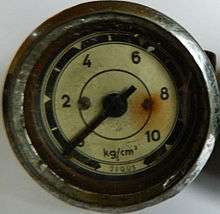Kilogram-force per square centimetre


A kilogram-force per square centimetre (kgf/cm2), often just kilogram per square centimetre (kg/cm2), or kilopond per square centimetre is a unit of pressure using metric units. Its use is now deprecated; it is not a part of the International System of Units (SI), the modern metric system.
Still, kg/cm2 remains active as a measurement of force primarily due to older torque measurement devices still in use. An interesting example of this use can be considered in the use calculation of Body Mass Index (BMI):[1]
This use of the unit of pressure provides an intuitive understanding for how a body's mass can apply force to a scale's surface area i.e.kilogram-force per square (centi-)metre.
In SI units, the unit is converted to the SI derived unit pascal (Pa), which is defined as one newton per square metre (N/m2). A newton is equal to a kg·m/s2, and a kilogram-force is 9.80665 newtons,[2] meaning that 1 kgf/cm2 equals 98.0665 kilopascals.
In some older publications, kilogram-force per square centimetre is abbreviated ksc instead of kg/cm2.
See also
- Technical atmosphere, another name for this unit
All the Russian origin gauges are indicating pressure in Kgf/cm2 and are calibrated annually.
References
- ↑ Team, PhysiologyWeb. "Body Mass Index (BMI) Calculator - PhysiologyWeb". www.physiologyweb.com. Retrieved 2016-10-19.
- ↑ The NIST Guide for the use of the International System of Units, National Institute of Standards and Technology, 18 Oct 2011